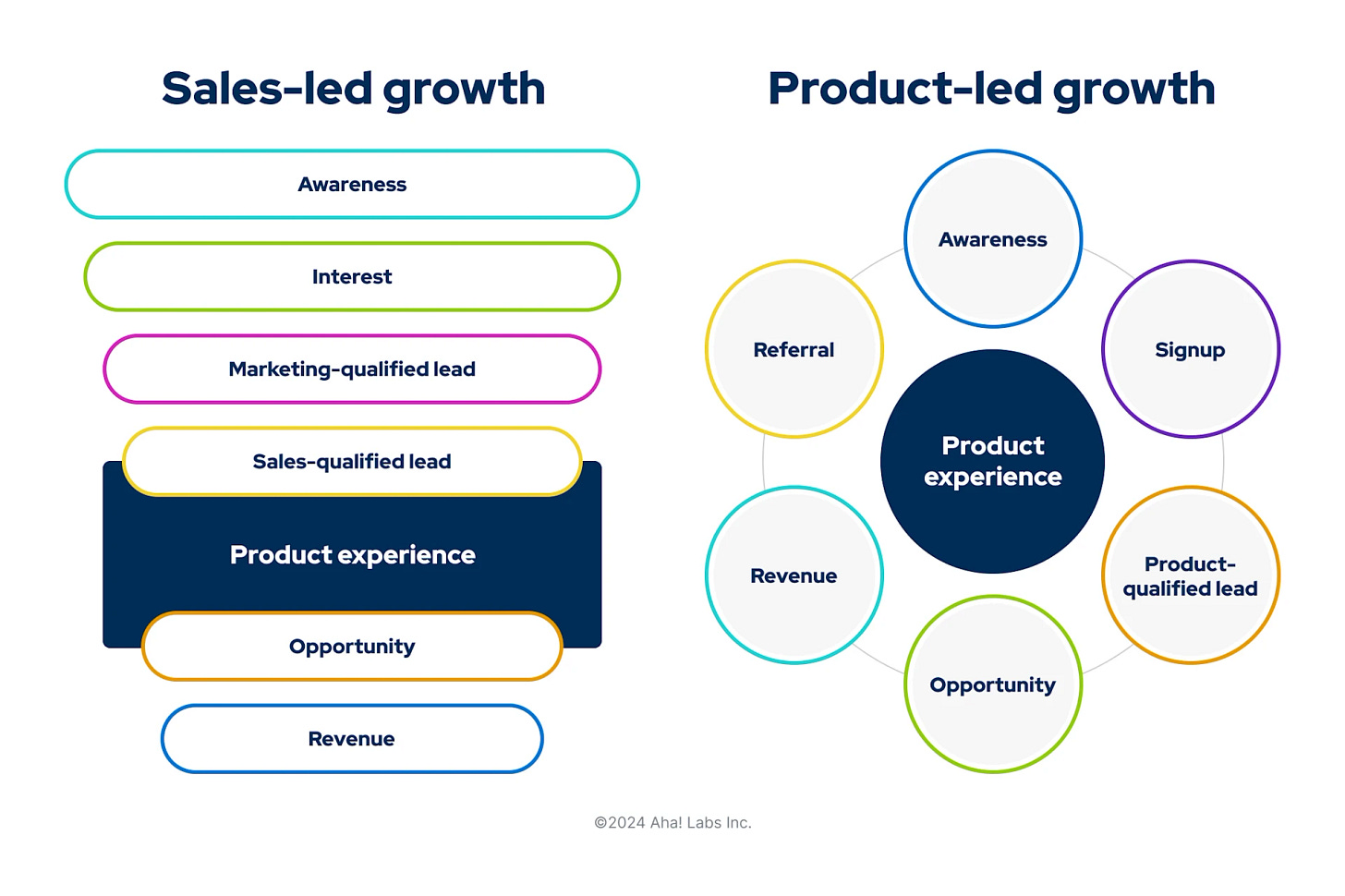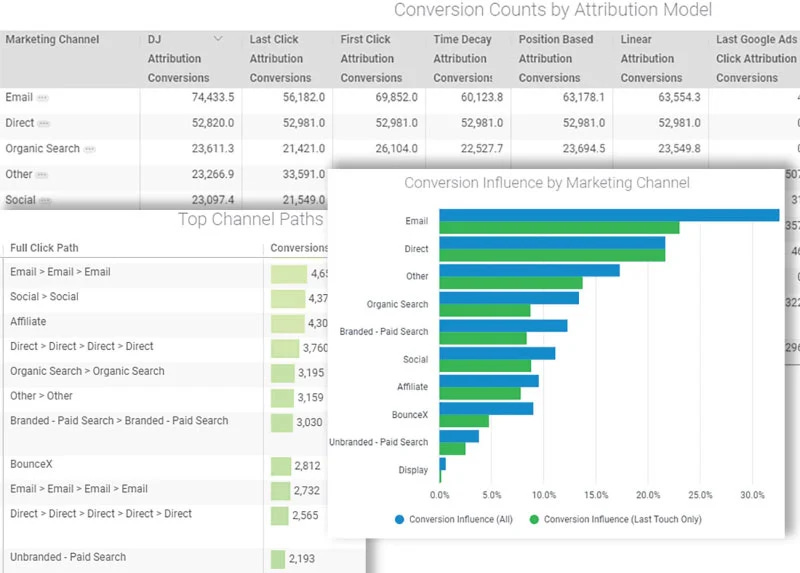I’ve been working in growth since 2013, and for a long time, the playbook barely changed. But a quiet revolution is underway.
Product-led growth is gaining traction. Tools like Clay and Unify are automating what used to be core sales functions. And after making a few hundred cold calls for a friend’s company, I saw firsthand how much harder it is to reach buyers who would rather conduct their own research.
It got me thinking - are we watching a permanent power shift in go-to-market? This week’s article explores the changes and their significance. Anyone not interested in reading the full article can find a summary here.
How Sales and marketing worked pre-AI
Historically, sales has driven revenue, while marketing has played a supporting role. Marketing would set the tone for the brand, lead content, and advertising efforts, and provide support for promotional events.
However, because marketing scored leads using superficial metrics such as e-book downloads, webinar attendance, and email opens, marketing-qualified leads (MQLs) were often considered low quality. Furthermore, because marketing and sales were typically separate functions and marketing success was usually measured by lead volume, marketing was incentivized to focus on driving lead quantity over quality, resulting in flaky leads that didn’t convert.
Sales, on the other hand, operated more like snipers. They would conduct research to identify prospects most likely to convert, then call or email them to qualify them, and finally close them at an opportune time. Sales-qualified leads (SQLs) were typically fewer in number but had a far higher close rate.
Sales was the “hands-on” team - lots of repetition, grunt work, and context switching to produce consistent, quantifiable results that justified their position at the top of the food chain.
AI has automated sales grunt work
With the ascent of AI, sales is rapidly transforming, with the vast majority of sales grunt work being automated:
List Building → Sales lists are built, enriched, and filtered automatically using tools like Clay, Apollo, and Phantombuster.
Email Writing → Emails are AI-generated and personalized at scale.
CRM Data → CRM updates are synced via integrations and activity tracking.
Lead Qualification → Bots, site questionnaires, PLG data, and intent signals do the heavy lifting.
Sequencing → Marketers or growth teams run multi-touch outbound campaigns, such as paid media, to drive growth.
In most traditional sales organizations, these tasks take up a considerable percentage of a sales rep’s time. In 2023, Verkada’s growth team found that their average SDR spent 70% of their time trying to reach a prospect (e.g. building lists, crafting messaging, cold calling, sending emails, and LinkedIn messages), and only about 10% was spent interfacing with potential customers. The rest of their time was spent on training or task switching.
The market has shifted in meaningful ways
In addition to AI automating a significant portion of sales tasks, the market has undergone a substantial shift in the past few years. A few of the most important changes are:
#1 - Cold calling success rates have fallen off a cliff
A large-scale study by Cognism found that in 2025, the average cold-calling success rate was 2.3%, a decline of more than half from the 2024 rate of 4.82%.
While Cognism acknowledges other factors may have also contributed to this precipitous drop, the point still stands that public perceptions about unsolicited calls are overwhelmingly negative. 92% of people believe calls from an unknown number are a scam and, therefore, won’t answer. 80% of prospects would rather talk to a salesperson via email than over the phone.
Buyers want to self-educate
In the past, sales reps controlled access to information, including pricing, case studies, and demos. Now, the best marketing teams intentionally open up that access. Before pulling the trigger, decision-makers evaluate the company’s thought leadership, social proof on platforms like G2, Reddit, and Twitter, content quality, and community engagement. Having a strong online reputation matters more than ever.
Prospects are happy about this shift. 75% of B2B buyers reported spending more time researching purchases and prefer a rep-free sales experience.
#3 - A greater percentage of companies are embracing product-led growth (PLG)
PLG is a strategy where users experience the product firsthand - often before speaking to sales - and the product’s value convinces them to convert, upgrade, or expand.
Given that fewer and fewer people want to be ‘sold to’ and prefer to conduct their own research and self-educate, it is not surprising that PLG motions have been gaining popularity. A recent report by ProductLed.com revealed that over 91% of B2B SaaS companies are doubling down on PLG. Those who adopted it early are already experiencing 63% faster growth compared to traditional sales-led businesses.
Some well-known PLG companies include Notion, Figma, Slack, Calendly, and Airtable.
Why marketing is best positioned to own the new GTM
Marketers have some unique advantages over salespeople that give them a leg up in transitioning to the new reality:
#1 - Marketing thinks in systems, not just touchpoints
Marketers are trained to build repeatable, scalable campaigns rather than relying on one-on-one outreach. The modern GTM motion is a system that encompasses various elements, including paid and organic acquisition, segmentation and targeting, personalization and nurturing, and conversion and expansion. This is a system, not a sequence of handoffs.
#2 - Marketing owns the key channels buyers actually use
Buyers no longer start their journey with a rep - they begin with:
-Google (SEO)
-LinkedIn and social (thought leadership, brand)
-Communities (Reddit, Slack, Discord)
-Product trials and website chat
Marketing already controls or influences all these channels - not sales.
#3 - Marketing owns attribution, analytics, and funnel visibility
Modern GTM depends on data-informed decision-making:
-What’s working?
-Who’s converting?
-Where is revenue coming from?
Marketing leaders (especially with RevOps or growth ops support) already manage:
-Funnel metrics
-Attribution modeling
-Conversion rate optimization
What will happen to sales?
Sales isn’t going away, but its role, structure, and scale are fundamentally changing. Sales will transition to a model with fewer representatives but more strategic roles and higher skill levels. There will be two primary lanes for top salespeople to slot into:
Technical Consultant: As products become more complex (especially with the rise of AI), representatives will need to understand APIs, workflows, and integrations, guide solution architecture, and translate business needs into product capabilities.
These reps will enter the funnel later when there is already clear buying intent. They will act as consultants, not just closers, and help buyers co-create solutions for expensive, highly customized implementations.
The Political Operator: In large deals, you’re not selling to one buyer - you’re managing 6–10+ stakeholders across:
-IT
-Procurement
-Legal
-Finance
-End users
These deals require building internal champions, coordinating timelines across teams, and navigating RFPs and approval layers. For such high-stakes deals, which require a lot of political buy-in, sales will do most of the heavy lifting. As I mention here, your custom AI sequence won’t replace Rick, who is business school friends with multiple corporate executives and loves to drink, golf, and talk shit.
One edge case that I would include in the Political Operator category is Field Sales, which is still common in old-school industries that operate at a slower pace.
Conclusion
The go-to-market landscape is changing fast. Tasks that once defined sales are now handled by AI. Buyers are doing more of their own research, demanding transparency, and making decisions without ever speaking to a rep.
In this new reality, the roles have flipped, and marketing is now the one driving the funnel. Sales still matters, but the handoff is happening later, and the bar is higher. The teams that win will be the ones who build systems and meet buyers where they are, not where they used to be.
If you liked this content, please click the <3 button on Substack so I know which content to double down on.
TLDR Summary
This article explores the shift in the B2B go-to-market (GTM) landscape, where product-led growth (PLG) and AI-driven automation are reshaping sales and marketing. With fewer buyers engaging with sales reps directly, marketing has become the primary driver of the sales funnel. The article highlights the changing roles of marketing and sales, the rise of PLG, and why marketing is now better positioned to lead the GTM charge.
Key Steps and Insights
Traditional Sales and Marketing Approaches
Historically, sales drove revenue, and marketing was a supporting function.
Sales worked directly with qualified leads (SQLs), while marketing focused on lead volume, often generating low-quality MQLs.
AI and Automation are Changing Sales
AI tools now automate much of the sales grunt work, including list building, email writing, lead qualification, and CRM management.
This has freed up sales teams to focus on more strategic roles.
The Shift in Buyer Behavior
Cold calling success has plummeted, with buyers increasingly preferring to research solutions on their own.
75% of B2B buyers spend more time researching purchases and prefer a rep-free experience.
The Rise of Product-Led Growth (PLG)
PLG, where users experience the product firsthand before engaging with sales, is growing rapidly.
Over 91% of B2B SaaS companies are adopting PLG, which has led to faster growth compared to traditional sales-driven businesses.
Why Marketing is Positioned to Lead GTM
Marketing is better suited for today’s GTM model because it controls the channels buyers use: search, social media, and product trials.
Marketing also owns attribution, analytics, and funnel visibility, allowing for data-driven decision-making.
Sales is Not Disappearing, but It’s Evolving
Sales will focus more on strategic roles such as technical consulting and navigating complex deals.
The “Political Operator” role will continue to manage large, multi-stakeholder deals, while field sales will remain in slower-moving industries.
Conclusion
The go-to-market landscape is evolving rapidly, with AI and PLG driving the transformation. While sales remains important, its role is changing. Marketing is now in the driver's seat, owning the funnel and meeting buyers where they are—online, researching, and self-educating. The most successful teams will be those who adapt to this new reality, building systems and strategies that align with today’s buying behavior.













I love the focus on marketing’s rising influence! Curious how you see this trend playing out for PLG companies vs. traditional enterprise sales orgs.
Interesting! I am seeing and hearing more about CoS being more involved with GTM as well. Have been wanting to learn more about this topic, thanks for writing this!